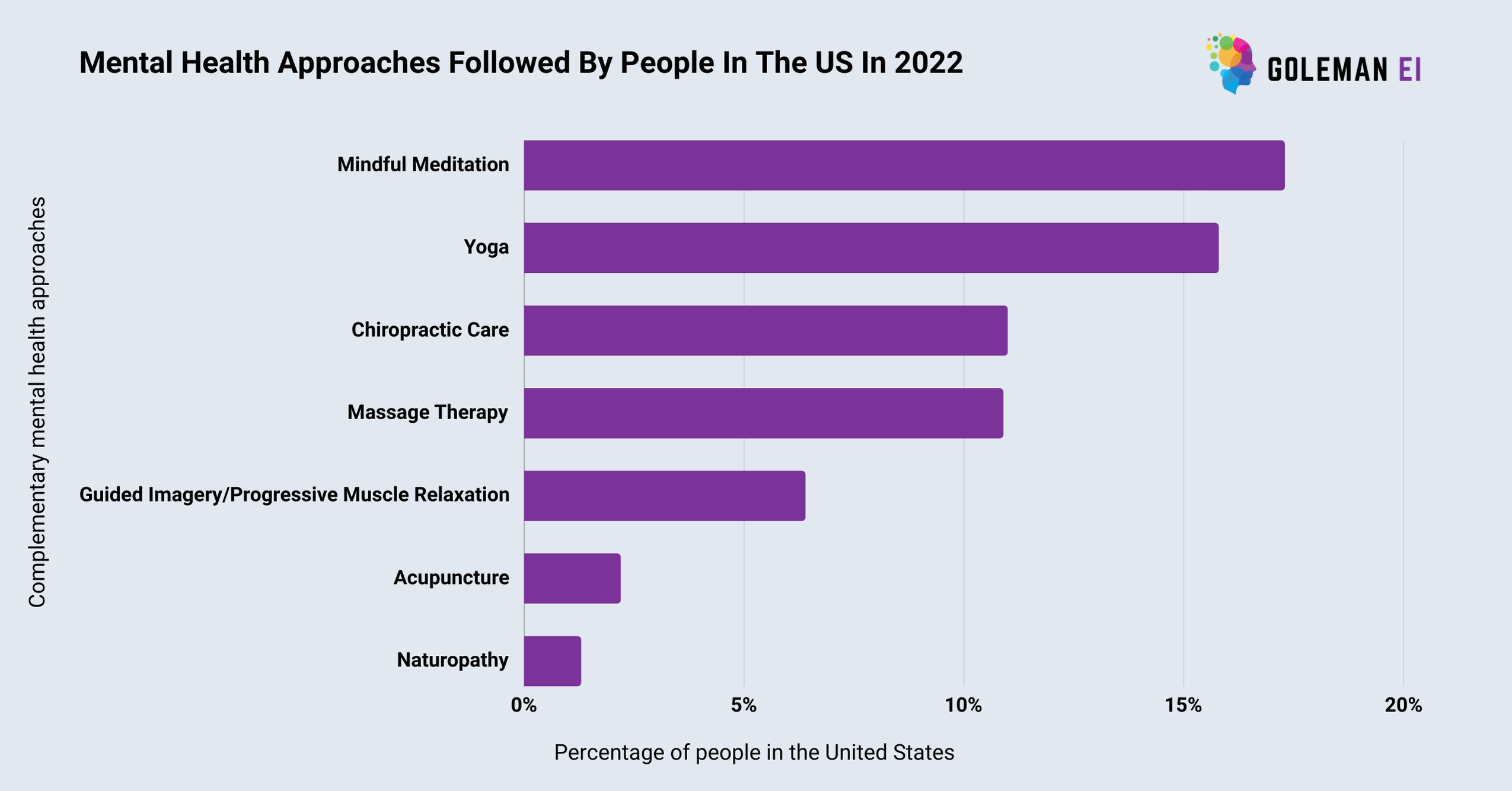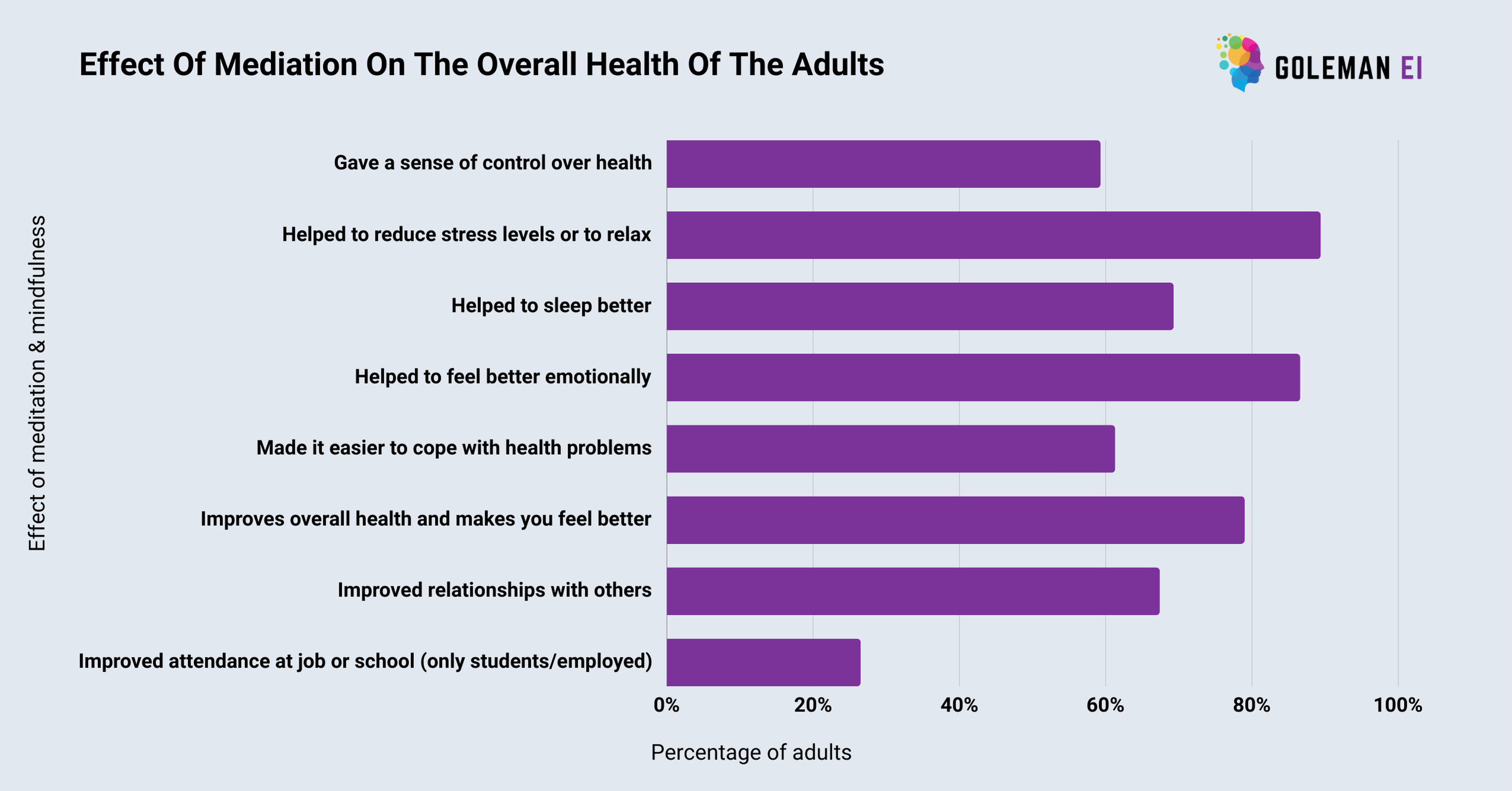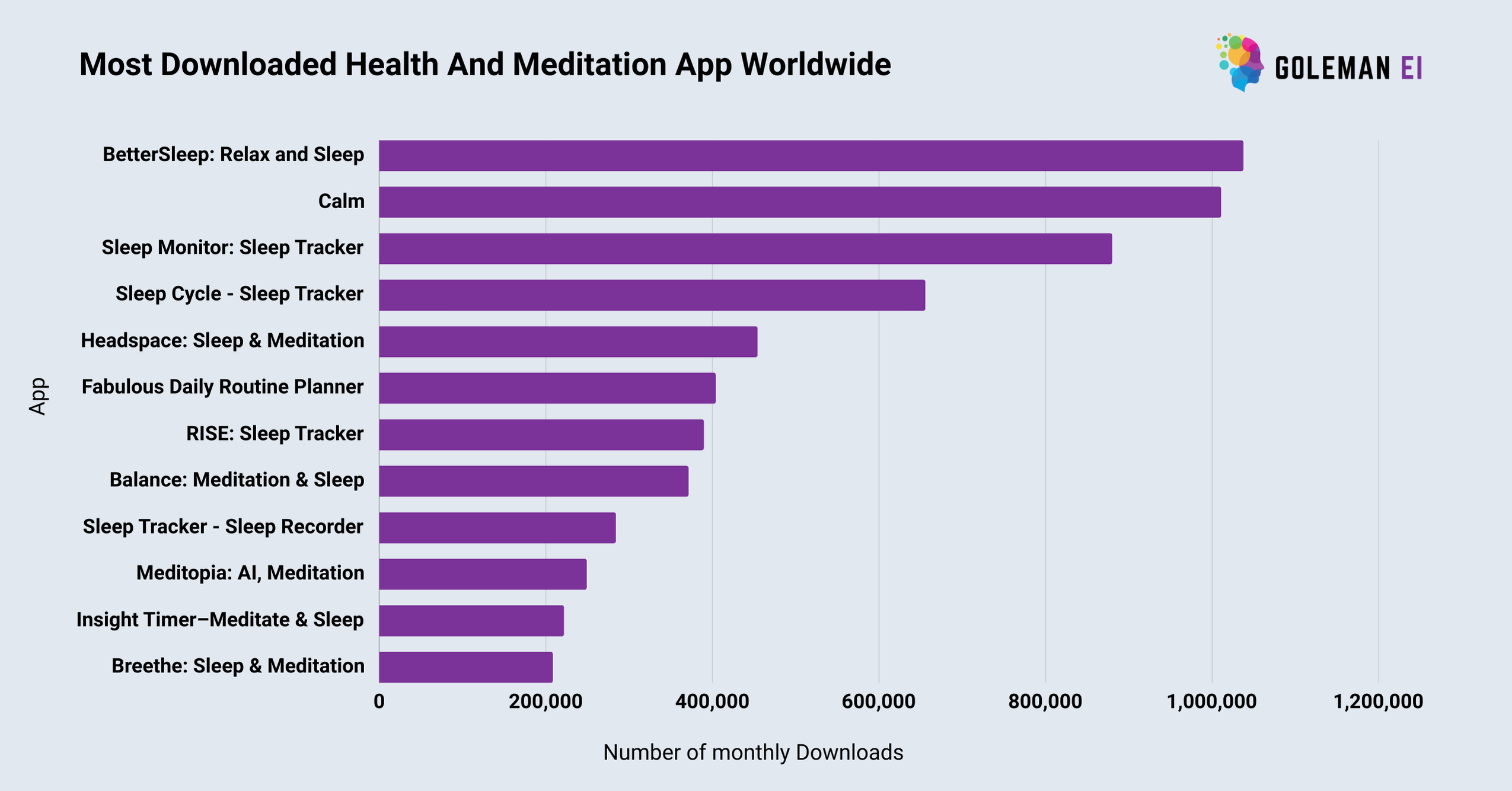Since Jon Kabat-Zinn introduced the Mindfulness-Based Stress Reduction (MBSR) program in 1979, mindfulness has gained immense popularity, changing Mindfulness Statistics globally.
With 17.3% of U.S. adults now practicing mindful meditation and an estimated 200 to 500 million people engaging worldwide, the practice has proven its impact across various aspects of life.
The stats speak for themselves, from global adoption trends to benefits in schools, workplaces, and mental health. Let us find out!
Mindfulness Statistics 2025 (Editors Pick)
- Between 200 and 500 million individuals globally engage in meditation and mindfulness practices.
- 65% of individuals with chronic pain conditions reported improved pain management after adopting mindfulness-based stress reduction (MBSR) programs.
- The share of adults in the United States practicing mindful meditation doubled from 2002 to 2022, from 7.5% to 17.3%.
- Practicing mindfulness can boost employee productivity and focus by 120%.
- Implementing mindfulness practices in the classroom led to a 9% to 15.4% increase in students’ GPAs.
- Within just two months, mindfulness practices reduced anxiety levels by 30%, proving to be as effective as conventional medication.
- 79% of adults reported that practicing meditation and mindfulness enhanced their overall health and well-being.
- In January 2024, Better Sleep topped the charts as the most downloaded health and meditation app globally, with 1.04 million downloads.
Global Mindfulness Statistics
- 200 to 500 million people worldwide meditate and practice mindfulness.
According to the latest estimates, 2% to 6.25% of people meditate worldwide.
The global meditation and mindfulness market is expected to grow by 18.7% CAGR from 2024 to 2028, with mindfulness programs increasingly integrated into workplaces and schools.
The popularity of mindfulness has spiked during the pandemic, and many people worldwide look forward to practicing mindfulness every year. The amount of time spent on meditating has grown by 2,900% since March 2020.
Source: MindWorks, Global Wellness Institute, Grand View Research
- The number of publications on mindfulness reached 2808 in 2020.
Until 2006, the number of publications on Mindfulness was less than 100 annually. However, between 2010 and 2020, the number of publications increased by 23.5% per year.
Besides, 16,581 publications on Mindfulness were published between 1966 and 2021, two-thirds of which were from 2016 to 2021.
At the same time, the number of reviews on Mindfulness has also increased, reaching a peak of 405 in 2019.
Source: ResearchGate, Mindful
Mindfulness In The United States
- The percentage of adults in the United States who practiced Mindful meditation doubled between 2002 and 2022.
In 2002, just 7.5% of the people in the United States practiced mindfulness; in 2022, this percentage reached 17.3%.
Mindful meditation was the most popular complementary mental health approach followed by people in 2022.

Here is a table displaying further details about the seven mental health approaches followed by people in the United States in 2022:
| Complementary Mental Health Approaches | Percentage Of People In The United States |
|---|---|
| Mindful Meditation | 17.3% |
| Yoga | 15.8% |
| Chiropractic Care | 11.0% |
| Massage Therapy | 10.9% |
| Guided Imagery/Progressive Muscle Relaxation | 6.4% |
| Acupuncture | 2.2% |
| Naturopathy | 1.3% |
Source: National Center for Complementary and Integrative Health (NCCIH)
- Approx 5 Million Americans struggle with betting addiction but only 8% of these individuals will ever seek help.
With nearly 5 million Americans reportedly struggling with betting addiction and only about 8% seeking help, it’s crucial to approach the topic with both awareness and responsibility.
Mindfulness practices have been increasingly recommended as supportive tools for recognizing triggers and regaining control. At the same time, for those who choose to engage, it’s important to do so through regulated betting websites on CricketPanda that promote responsible gaming and user safeguards. Such apps can help you stay regulated while also letting you enjoy betting in a controlled environment.
Source: AddictionHelp
Demographics Breakdown Of Mindfulness Practitioners In The United States
- 2.1% of women reported that they practiced Mindfulness, while 1.7% of the men stated the same.
On the other hand, 20.6% of the meditating women and 31.5% of the meditating men stated that they practiced mindfulness.
Male meditators used mantra, mindfulness, and spiritual meditation more frequently. On the other hand, women meditators preferred to pair meditation with yoga, tai chi, or qi gong.
Source: National Center for Biotechnology Information (NCBI)
- 15.9% of the adults aged 45 to 64 years practiced Mindfulness meditations.
According to a 2017 survey conducted in the United States, the largest share of the adults who practiced Mindfulness belonged to the 45 to 64-year age group.
Moreover, 13.4% of the adults aged 18 to 44 and another 13.4% of the adults aged over 65 practiced mindfulness.
Here is a table displaying a detailed breakdown of the people in the United States who practiced mindfulness meditations by age:
| Age Group | Percentage Of Adults In The US |
|---|---|
| 18 to 44 years | 13.4% |
| 45 to 64 years | 15.9% |
| over 65 years | 13.4% |
Source: NCHS
Benefits Of Mindfulness
Over 65% of individuals with chronic pain conditions reported improved pain management after adopting mindfulness-based stress reduction (MBSR) programs. (Source: NCBI)
The benefits of mindfulness can be observed in various aspects of our lives. Mindfulness is more likely to positively affect our mental and physical health and improve people’s efficiency in student life and work.
Various studies and research conducted over the years have helped us better understand the benefits of adopting mindfulness in our daily lives.
Benefits Of Mindfulness In The Workplace
- Mindfulness increases the productivity and the focus of the employees by 120%.
At the same time, regular and well-practiced mindfulness also led to an 85% decrease in absenteeism.
Additionally, businesses that had meditation programs for their employees witnessed an increase of 520% in their profit.
Further, 60% of the employees who experienced anxiety at their workplace showed an improvement in their mental health at work after practicing mindfulness meditation.
Source: Steeve Gooch
- Over half of American employers offer mindfulness training to their employees.
These investments contribute to the global corporate wellness market, valued at over $50 billion.
Source: Harvard Business Review
Benefits Of Mindfulness In Schools
- Practicing mindfulness in the classroom reduces students’ behavior problems by 60%.
At the same time, practicing mindfulness helped minority students close the achievement gap with their white classmates in multiple subjects by 20% to 30%.
Source: InnExplorer.
- Adopting Mindfulness in the classroom improved the students’ GPA by 9% to 15.4%.
The students’ grades in the schools that included mindfulness in their classrooms increased in most subject areas.
A significant improvement was seen in maths, where the grades improved by 18% to 28%. Further, the students’ science grades increased by 20% to 23%.
Additionally, the scores of these students on standardized reading tests increased by 13%.
Here is a table displaying the increase in students’ grades in different subjects after they adopted mindfulness in their classrooms.
| Subject | Increase In Grades |
|---|---|
| Maths | 18 to 28% |
| Science | 20% to 23% |
| Reading | 9% to 18% |
| Social Studies | 12% to 30% |
| Writing | 9% to 13% |
| Standardized Test Scores in Reading | 13% |
Source: InnExplorer.
Benefits Of Mindfulness On Mental Health
- Mindfulness helped to reduce anxiety levels by 30% in 2 months and was found to be as effective as a standard drug.
In 2022, a study conducted highlighted that Mindfulness meditation worked head-to-head as a standard drug for treating anxiety.
In this study, the participants were randomly assigned to either use generic drugs daily or attend a mindfulness program.
After two months, the anxiety levels in the participants decreased by 30% in both groups, and they continued to decline for the following four months.
Source: AP News.
- 17.5% more people who received MBCT self-help recovered from depression than from CBT self-help.
In a study conducted, 63% of the participants who received Cognitive behavioral therapy (CBT) self-help recovered from depression.
On the other hand, 74% of the people who were treated with mindfulness-based cognitive therapy (MBCT) self-help recovered from depression.
These numbers proved that mindfulness was more effective than cognitive-behavioral therapy in treating depression.
Source: The Guardian
- Children slept for an additional hour after taking mindfulness training.
According to a 2021 study, elementary school children who participated in mindfulness training twice a week for two years experienced an average increase of 74 minutes of sleep per night.
This increase in overall sleep time also encompassed an extra 24 minutes of rapid eye movement (REM) sleep, the phase where memories are consolidated and stored.
Source: CNN
Benefits of Mindfulness On Physical Health
- 60% of the people practiced meditation and mindfulness to improve their energy.
At the same time, 1 in 2 adults stated that meditation helped them to improve their memory or concentration.
Meanwhile, 1 in 3 adults said they practiced meditation to enhance their immune systems.
Here is a table displaying why adults practice meditation and mindfulness.
| Reason For Practicing Meditation And Mindfulness | Percentage Of Adults |
|---|---|
| For general wellness or general disease prevention | 76.2% |
| To improve energy | 60.0% |
| To improve immune function | 33.8% |
| To improve athletic or sports performance | 18.4% |
| To improve memory or concentration | 50.0% |
Source: National Center for Biotechnology Information (NCBI)
- 61.3% of the adults stated that meditation and mindfulness helped them to cope with health problems.
According to a recent survey, over three-in-five adults stated that they could overcome their health problems by adopting meditation.
Further, nearly 9 in 10 people stated that meditation and mindfulness helped reduce stress or aid relaxation, while almost 4 in 5 adults said that their overall health improved.

Here is a table displaying the effect of mediation on the overall health of the adults:
| Effect Of Meditation And Mindfulness | Percentage Of Adults |
|---|---|
| Gave a sense of control over health | 59.3% |
| Helped to reduce stress levels or to relax | 89.4% |
| Helped to sleep better | 69.3% |
| Helped to feel better emotionally | 86.6% |
| Made it easier to cope with health problems | 61.3% |
| Improves overall health and makes you feel better | 79.0% |
| Improved relationships with others | 67.4% |
| Improved attendance at job or school (only students/employed) | 26.5% |
Source: National Center for Biotechnology Information (NCBI)
Mindfulness Apps Statistics
- The mobile meditation and mental wellness app market is estimated at $1.64 billion.
The market worldwide was valued at $1.39 billion in 2023, an increase of $0.25 billion from 2023 to 2024.
Further, the mobile meditation and mental wellness app market is estimated to reach a valuation of $7.25 billion by the end of 2033.
Here is a table displaying the Mobile meditation app market size worldwide over the years:
| Year | Mobile Meditation App Market Size Worldwide |
|---|---|
| 2023 | 1.39 billion |
| 2024* | 1.64 billion |
| 2025* | 1.93 billion |
| 2026* | 2.28 billion |
| 2027* | 2.69 billion |
| 2028* | 3.17 billion |
| 2029* | 3.74 billion |
| 2030* | 4.42 billion |
| 2031* | 5.21 billion |
| 2032* | 6.15 billion |
| 2033* | 7.25 billion |
*- projected values.
Source: Statista.
- Better Sleep was the most downloaded health and meditation app worldwide in January, with 1.04 million downloads.
Calm was the second most downloaded app worldwide, with 1.01 million downloads recorded in January 2024.
Other mindfulness apps that were downloaded the most worldwide were Sleep Monitor and Sleep Cycle.

Here is a table displaying the number of monthly app downloads recorded.
| App | Number Of Monthly Downloads |
|---|---|
| BetterSleep: Relax and Sleep | 1,037,568 |
| Calm | 1,010,835 |
| Sleep Monitor: Sleep Tracker | 880,080 |
| Sleep Cycle – Sleep Tracker | 655,787 |
| Headspace: Sleep & Meditation | 454,321 |
| Fabulous Daily Routine Planner | 404,184 |
| RISE: Sleep Tracker | 389,908 |
| Balance: Meditation & Sleep | 371,448 |
| Sleep Tracker – Sleep Recorder | 284,227 |
| Meditopia: AI, Meditation | 249,142 |
| Insight Timer–Meditate & Sleep | 221,919 |
| Breethe: Sleep & Meditation | 208,525 |
Source: Statista.
Conclusion: Practicing Mindfulness Improves Mental As Well As Physical Health
Mindfulness has proven to be an excellent tool for improving concentration, stress management, and physical health. As a result, Mindfulness apps have managed to grab people’s attention; hence, their market is estimated to reach $1.64 billion.
Besides, over 1 in 2 students and employees could benefit from practicing mindfulness and improving their school or work performance.
It is easy to conclude that, through personal practice or structured programs, mindfulness offers a pathway to enhanced well-being and resilience in today’s fast-paced world.
